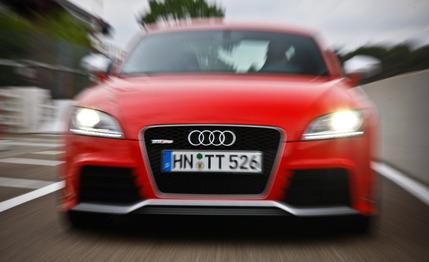
 First Drive Review
First Drive Review


Audi might be the hottest brand among luxury carmakers—more styling-oriented and more sporty than others, but still something of an insider's tip. What the brand doesn't have is a history as rich as that of Mercedes-Benz, or even BMW. Audi can be traced back to a number of companies originating as early as 1899, but the brand, as we know it today, did not surface until the 1960s—with some rather bland cars.
It took Ferdinand Piëch, now head of Volkswagen's supervisory board, to turn Audi into a high-tech, premium carmaker. As Audi's chief engineer, he pushed for projects such as the charismatic five-cylinder engine, Quattro all-wheel drive, turbocharged engines, and, ultimately, Audi's advance into the luxury segment with the all-aluminum A8.
Almost 30 years after the launch of the original Quattro, Audi is unveiling the TT RS. We have tried this car, which is unapologetically playing the theme of that legendary Audi 4000–based coupe named Quattro that dominated the international rally scene for years.
And here we thought the 265-hp Audi TTS was just fine. Its high-output, turbocharged four-cylinder gives the Porsche Cayman a run for the money, and it is a credible, sporty alternative to the silky 3.2-liter V-6 TT.
But deep within Audi, engineers wouldn't rest. Few of them understood why the legendary inline-five was ever dropped from the lineup. They wanted a new five-cylinder powerplant. Of course, the TT, based on VW’s flexible PQ35 platform, still had potential. Audi's Quattro GmbH performance division came up with a plan.
Searching for More Turbo Power
Options were evaluated. According to engineers, the 2.0-liter TFSI four-cylinder is reaching its limits in the Audi S3 and VW’s upcoming Scirocco R and Golf R; At 265–270 hp, this four is still a well-behaved unit with controlled turbo lag after launch. But add a bigger turbo for another 40 or so hp, and you get an old-school turbo—lots of lag, with full boost coming at higher rpm. Turbocharge the 3.2-liter VR6, or the 3.6-liter variation sold in the Volkswagen CC? Possible, but VW and Audi are phasing out this engine because it is not in step with fuel-economy requirements.
There was a third option, off the radar screen for most European observers: Tweak VW's 2.5-liter, five-cylinder unit produced in Mexico for the U.S.-market Rabbit/Golf and Jetta. This sturdy 170-hp unit is not exported to Europe. It was developed as a low-cost engine to cater to the North American preference for displacement. In Europe, where the focus is on power and torque instead of cubic inches, this straight-five's job is far more efficiently accomplished by the 1.4-liter twincharged four.
The Mexican inline-five is based on VW's venerable four-cylinder engine code-named EA113. Michael Dick, Audi's board member for R&D, remembers: "For the Mexican engine, we added one cylinder to the four-cylinder unit, and we used a cylinder head basically coming from the Lamborghini Gallardo V-10. The focus was low cost." Dick smiles as he describes how Audi engineers added direct-fuel-injection technology, an intercooler, and a turbocharger with up to 17 psi of boost to create an adequate TT RS powerplant. The result: 340 hp at 5400 rpm and a 7000-rpm redline, twice the power of the naturally aspirated engine.
Thanks to direct injection, there is instant torque even at low rpm and before the turbo kicks in—and it kicks in quickly. From 1600 to 5300 rpm, 332 lb-ft are on tap. This engine does everything well. You can cruise along lazily in top gear, or you can rev it up to the limiter, which you are guaranteed to hit if you don't watch the tachometer because the boost just does not drop off. This is one of the few turbo engines that accelerate seamlessly and eagerly beyond redline.